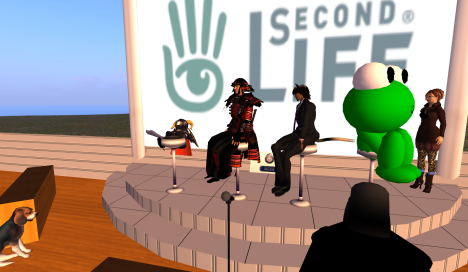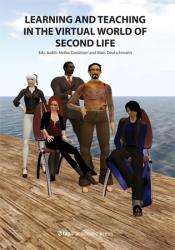Would you believe ‘Kermit?’

People like to have fun with their avatars but, is a big, green, frog credible as a senior Linden Lab executive (no don’t say it), a large organisation’s Chief Financial Officer authorative as a friendly Beagle pup, or a renowned educator and SL guru believable as a flittery, monarch butterfly?
It’s a shame, when one can be “anything” in Second Life, that educators and others in leadership roles, if they want to achieve anything based around credibility, cannot and should not, in my view, adopt/create avatars that are distracting, disruptive, incredible, discreditable or just downright tacky and/or profiles, including picks, that provide a counter-productive message.
I believe, in this period before Ray Kurzweil’s Singularity occurs and we evolve into online beings, that the real life humans behind the screens of all avatars – particularly students – are inherently conservative and are conditioned to seeing their educators, even if no longer “the sage on the stage”, as credible representations of earthbound homo sapiens, adhering to an appropriate standards of appearance, costume, gesture and language.
To me, possibly because of my conditioning (and age), – and I know this is probably not politically correct – a frog or a minotaur, a furry anthromorph or a centaur, a werewolf or a butterfly, a man without a head, a male avatar with an exposed penis or a female avatar with exposed nipples, are at the very least distracting and at worst destructive of any learning impulse I or any other student might have.
The same goes for avatar naming, costuming and profile writing: if an authority figure has a name like “Jerkoff Nightly” ( a name rejected by the Lindens) is wearing filmy kajira (Gorean slave girl) silks or features in their picks the stores of Stroker Serpentine, xCite or a BDSM sim, I probably would not learn much from him/her either, athough, as some “with-it” educators have said to me, its obviously my problem rather than their problem
This issue was brought home to me at a recent Linden press conference where the figure who had the most to impart was a large, green frog [pictured above (right) with the knight (centre) and the Beagle (left) plus others].
Another key player was the tiny, armoured knight almost lost on a stool, while the Linden Lab CFO , who also had important information to give, was the friendly Beagle.
Geeks may be united in seeing nothing wrong with this sort of roleplaying in “real” situations, be they business or education, in SL: Geeks, however, no longer represent the majority of people entering virtual worlds. The masses coming in now are real people conditioned by the real world.
The perception of these “reasonable” people is important.
No matter how much one would hope otherwise we do bring our perceptions with us from real life into the SL world for better or worse. This has been demonstrated on a number of occasions with a lack of equal-treatment by SL residents for dark-skinned avatars. It’s also shown in the disregard some have for SL furries.
I have nothing against fantasy avatars for fun but educators and business types must remember that their “working” avatar is yet another tool that they have available to interact with the world: if they are only there to have fun as a fantasy figure it is fine to adopt a fantasy avatar but if they are in world to impart serious information/work that they want to be believed then their avatar should be packaged accordingly. In real life even Heidi Klum would not wear a lingerie to a normal business meeting nor Hilary Clinton a frog costume to a cabinet meeting.
I have no actual research to back my thoughts on avatar credibility but I have been in virtual world’s long enough to know that the best-looking, attractive, human-like avatars with easy-to-remember names are generally the ones who get the best initial results in social interaction. It then remains for them to hold this position through their communication skills.
No matter how good a communicator one is, the wrong choice of name, avatar or costume or inappropriate words on a profile, I believe, could put one behind the eight-ball, if not get one laughed out of the virtual classroom or business meeting.
That is both a waste of time and money.
What do you think?
Valuable ‘roadmap’
 A valuable addition for educators working in or planning to move into education in virtual worlds, the newly-published “Learning and Teaching in the Virtual World of Second Life”, provides a roadmap to SL instructional design, learner modeling, building simulations, exploring alternatives to design and integrating tools in education with other learning systems.
A valuable addition for educators working in or planning to move into education in virtual worlds, the newly-published “Learning and Teaching in the Virtual World of Second Life”, provides a roadmap to SL instructional design, learner modeling, building simulations, exploring alternatives to design and integrating tools in education with other learning systems.
Published in English by the Tapir Academic Press, of Norway, the book has been edited by Judith Molka-Danielsen (SL: Aklom Haifisch) and Mats Deutschmann (It’s available for 350,00 kr from http://butikk.tapirforlag.no/en/node/1195).
 Molka-Danielsen (pictured), one of the more experienced European academics in SL, is associate professor (Førsteamanuensis) with the Department of Informatics at Molde University College (Norway). Teaching and doing research within the Information Management program at the university she leads a research group and manages Kamimo Education Island in SL (Kamimo Island (134, 162, 25), a virtual platform for education, co-developed by Molde University College, the University of Kalmar (Sweden) and the University of Central Missouri (USA). The island has been developed by Design Container.
Molka-Danielsen (pictured), one of the more experienced European academics in SL, is associate professor (Førsteamanuensis) with the Department of Informatics at Molde University College (Norway). Teaching and doing research within the Information Management program at the university she leads a research group and manages Kamimo Education Island in SL (Kamimo Island (134, 162, 25), a virtual platform for education, co-developed by Molde University College, the University of Kalmar (Sweden) and the University of Central Missouri (USA). The island has been developed by Design Container.
This book, which includes input from some of the smartest educators in virtual worlds from across the real world, is based on the experiences at Kamimo, the first Scandinavian project to experiment with the design and testing of teaching platforms for life-long learning in SL. Besides detailing the experiences and lessons learned in that project and from other educational projects in SL the book identifies the gaps in traditional forms of education.
With a preface by Graham Davies the book includes contributions from Mats Deutschmann & Luisa Panichi, on Instructional Design, Teacher Practice and Learner Autonomy; David Richardson & Judith Molka-Danielsen on Assessing Student Performance; SLENZ’s Dr Clare Atkins & Mark Caukill on Serious Fun and Serious Learning: The Challenge of Second Life; Lindy McKeown on Action Learning in a Virtual World; Bryan W. Carter, on Enhancing Virtual Environments; Bjørn Jæger & Berit Helgheim on Role Play Study in a Purchase Management Class; Marco Bani, Francesco Genovesi, Elisa Ciregia, Flavia Piscioneri, Beatrice Rapisarda, Enrica Salvatori & Maria Simi, on Learning by Creating Historical Buildings; Toni Sant, on Performance in Second Life: some possibilities for learning and teaching; and James Barret & Stefan Gelfgren, Spacing Creation: The HUMlab Second Life Project.
It concludes with Mats Deutschmann & Judith Molka-Danielsen discussing Future Directions for Learning in Virtual Worlds.
So you need a Holodeck?
I”m indebted to Thinkerer Melville for showing me just how useful Holodecks can be in saving prims in an education or business environment. Re-introducing the idea of using a holodeck as a prim miser he created the video above to hammer home his point that holodeck scenes do not use up prim allocation except when they are in use. It was something that I had forgotten for the moment – but its something that might prove useful for educators looking for another lecture hall or workshop which wont take extra prims when students are not on hand.
He noted that Butch Dae, the inquiring character in the video, had collected a whole simful of holodeck builds, some bought from Novatech where the machinima was shot, and others obtained for free (http://rezzable.com/blog/thinkerer-melville/holodeck-made-business).
Butch can be IMed in world if you are “seeking better/faster/cheaper ways of finding, storing, retrieving information to in turn create knowledge faster.”
Filed under: Education, Virtual Worlds | Tagged: Atkins, avatar appearance, Dae, Design Container, holodeck, Kamimo, Kurzweil, Melville, Molde University College, Molka-Danielsen, Novatech, on-line identity, profiles, rezzable.com, Singularity, Tapir, University of Central Missouri, University of Kalmar |



My comment got far to long to take up the space here, so I have responded on my own blog with a link back to this post. You can read my response at http://eloisepasteur.net/blog/index.php?/archives/252-Wouldnt-you-believe-Kermit.html
Hi Johnnie :)
Please post separate posts separately so I can respond to each one individually! Thankyou!
Specifically, your first (extremely narrow minded, bigoted, conservative, phobic) post. (I’ve got lots to respond to)
Color me progressive!
The world is what you make it!
~!W
I’ve not felt motivated to comment on any of the posts previously, but on this one I have to say that it is the creativity of the avatar is what I look for in a virtual persona. If they turn up as the default avatar I may well ignore them and deem them uninteresting. I once had a most engaging intellectual conversation with a meatball. Let’s not be old-fashioned, unimaginative and boringly morphist John. Let’s challenge our students to display their creativity within their avatar in ways that are not possible in our somewhat tedious and mundane physical world. Or shall we have a rule to adopt a suit and tie on Koru? In which case I will arrive naked!
John,
I don’t have any problems with the students being anything they want to be and in any form they want to be: after all students have always been different from faculty *grin*. I know I was in word, thought, deed and appearance, although the younger members of the faculty, even though they were over 30 and could not be trusted,, very quickly aped our hair and our costumes – and also our mores.
My main thrust is that educator-avatars should think of the message they convey with their avatar appearance and profile – not that their creativity should be confined by any regulation.
However, I believe there are certain limits that have to be observed by educators within any environment be it virtual or real.
John,
You appear to be talking from a very narrow stereotypically academic viewpoint, that of a classroom teacher with younger students. The majority of my students are adults aged 25+ so more like the faculty you refer to. I would not dream of confining their ability to express themselves nor my own. Doing so would be like imposing school uniform on them and expecting me to turn up in a mortar board and black cape with scripted chalk dust! The point that I am trying to make is (and I am in effect agreeing with you) that indeed the message IS in our appearance and it is for this very reason that Faculty in particular should never appear in a suit and tie. If they identify as a furry, a Gorean Minotaur or a meatball then that is THEIR message and we should accept that as their persona. What right have you or I to dictate personal appearance in such an Evangelical manner? I do accept that an engorged phallus is inappropriate for classroom teaching but I think you’re taking things to an absurd extreme here to underpin a weak position that no-one appears to support, unless you have actually attended such classes? If so, and the appearence message is so important, why did the class not end immediately with scandalised avatars scattering in all directions? Simply because, as has been explained elsewhere, appearence in-world is not interpreted in the same way as in the real world.
John,
No. I’m NOT talking as a classroom teacher with younger students. I’m talking as, what is often described in legal jargon, “a reasonable person” off the street ,as it were.
Personally I have no interest in what avatar/profile picks etc one chooses: I just think educator-avatars should consider the ramifications of their choices and the possible costs, both to themselves and to their institutions and to the credibility of Second Life as a whole. Unlike “run-of-the-mill avatars in Second Life educators are not anonymous but are identifiable by their students, faculty, media and anyone else who cares to audit their classes/blogs etc. For others, Second Life TOS, in fact, prohibits their real life identification or dissemination of that identification by any third party. Educators cannot avail themselves of this protection because they already have identified themselves through their classes.
I would suggest rather than thinking about ideology you think about the reality.
By the way the SLED list is currently canvassing all points of view, many similar to yours.
I am also grateful that you have participated in the debate.